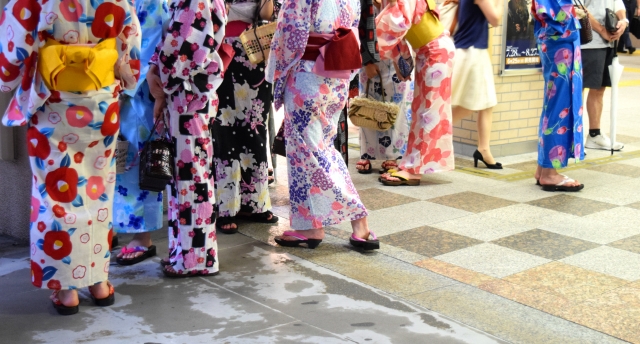It is very easy to recognise the traditional Japanese clothing of the yukata and kimono when you see one, they are very distinct garments. However, many people will not be aware of the difference between the two. The origin of the Japanese kimono is from the Chinese traditional Han clothing, although an apron was still worn over it. Over the ages, the kimono developed in line with Japanese aesthetic ideals and manufacturing processes to what you can see today. This article will show some differences you may notice between the kimono and yukata. But first, let’s see what they have in common!

Left Over Right
Regardless of the differences between kimono and yukata, there is one very important rule for both. You must wear the left panel over the right! Wearing them the other way around is seen as extremely rude in Japanese culture, as those who have passed away are dressed in a right-over-left kimono. So just make sure to double-check how you are wearing either your kimono or yukata before leaving the house.
Shape
Arguably, the main difference between a kimono and yukata is the collar. A kimono has a soft, full-width collar; whereas a yukata has a half-width and stiffer collar, due to the material it is made from. In addition, a kimono typically has at least two collars, one close to the neck and one just below called a juban collar. A yukata only has one collar as a juban collar isn’t worn below.
A second distinctive shape difference between a kimono and yukata is the length of the sleeves. The sleeves on a kimono vary according to different factors, such as age and the solemnity of an event. Unmarried women wear kimono with sleeves that are very long, so long that they can touch the floor. Traditionally, this allowed for eligible men to recognise which women were available for marriage. There are also kimono that have medium length sleeves. On the other hand, the yukata will not have sleeves longer than around 50cm, so they won’t ever touch the ground.
Material
Kimono are usually made of silk; silk is traditionally a more luxurious material and reflects the aesthetics of the kimono. On the other hand, the yukata is often made of cotton or polyester, this makes the yukata cheaper than kimono and also cooler for wearing during the summer.
Composition
Another difference in material is the lining when wearing a kimono, a lining is worn underneath the patterned silk layer. With yukata, a lining is never worn, again as they are intended for summer use a lining would make it too hot. The kimono also has more aspects than just the patterned silk and lining.
Sleeves
The sleeves on a kimono vary according to many different factors, from age to the solemnity of the event you are attending. The kimono with the longest sleeves are Furisode kimono. These sleeves are so long that they can touch the ground, they are exclusively worn by unmarried young women. This allowed eligible men to know which women were available for a marriage proposal, although today this fact is not as well known. There are also different forms of sleeved kimono which have medium length sleeves also. In comparison the yukata will never have sleeves longer than around 50cm, so they won’t touch the ground ever.
Seasons
If you see someone in winter wearing a garment and aren’t sure if it is kimono or yukata, it is surely kimono! You will not see someone outside wearing a yukata except for during summer. As they are only one layer without lining, they do not protect from the cold. On the other hand, kimono can come with all sorts of accessories to make them suitable for all the seasons, for example, a fur shawl for the winter. Yukata are sometimes worn in other seasons inside a ryokan or hot spring resort as they are usually given out to guests to wear, but they won’t be travelling outside!
Occasions
Kimono and yukata are often worn for different occasions. Yukata are commonly worn in the summer months to attend matsuri of fireworks or other summer festivals. Kimono are often worn for more formal occasions, such as first prayer of the new year or graduation from high school. Of course, anyone can wear kimono or yukata any time they want also. You may even see people in Japan going about their everyday business in these traditional dresses!










